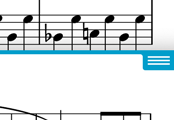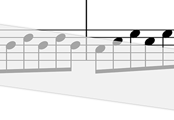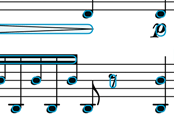Version 14.4.3
The current version of forScore is 14.4.3. If you're experiencing issues while using an older version, updating may help.Otherwise, the easiest way to fix intermittent issues is to quit and relaunch the app. Find out how here.
User Guides
For more in-depth information, check out our user guides.Additional Support
For personalized support, forScore Pro subscribers can contact us directly by opening forScore's Tools menu and choosing 'Support.'If you wish to submit feedback and do not need a response or if you have pre-purchase questions, click here to send us a message.
Please read our support policy here. We are generally unable to provide personalized support and replies are not guaranteed, especially for topics addressed on this page or in our user guide.
Working with Bookmarks
Extracting bookmarks as separate PDFs
If you’ve created a bookmark with a start and end page, you can use forScore’s sharing functions to export just those pages if needed. Swipe from right to left over a bookmark in a menu and tap Share or open the bookmark and choose Share from the tools menu. You can export bookmarks as PDF files (with or without annotations) or as 4SC files for use by other forScore users.
To save the bookmark as a new PDF file within your forScore library instead of sharing it, open the Rearrange panel while viewing your bookmark then choose “Save As…” and supply a title.
Using Indexes to create bookmarks
About Indexes
When you’re using one long PDF file with multiple pieces within it, bookmarks are an essential part of ensuring that forScore can be at its best, giving you all of the great features you’d get with individual PDF files for each score.
Since adding bookmarks can be a daunting and time-consuming task, use the Indexes feature to create bookmarks from a comma-separated value (CSV) file. To begin, import a CSV file by downloading it through the Services panel, copying it to forScore from another app (or using Drag and Drop), or by adding it to your forScore library from a computer using Apple’s File Sharing panel.
Importing Data From Indexes
While viewing your score, open the Bookmarks menu and tap “Indexes” in the top left-hand corner and choose your CSV file. Values found in each column are listed in the “values” section—tap any of them to assign their information to specific types of forScore metadata, then browse through each record to make sure things look right. The minimum values to create bookmarks are title and starting page; if you want to be able to add individual metadata or add bookmarks to setlists, you’ll also need to set an end page. Set a page offset value, if necessary, and check the thumbnail preview to make sure each bookmark lines up correctly. Skip any header or footer rows as needed, then tap “save” when you’re ready.
If you have multiple CSV files that are structured similarly, you can save and reuse your current value mapping in the future by selecting “default to these settings.” Each time you repeat this process, those settings will be applied by default and you can make any changes, if necessary, before importing the data.
About the CSV Format
CSV files are text documents whose contents follow certain rules. Each line of text (with a newline or carriage return character at the end) contains one or more values separated by a comma. Since newline characters and commas are both used structurally, there are certain rules for how they must be used within values (e.g. if the name of a bookmark is supposed to contain a comma it should be surrounded by double quotes).
In most cases, using a spreadsheet editor is easier and will ensure your data fully conforms to the CSV specification. A CSV file that contains the text shown below, when opened in a program like Excel or Numbers, will be properly formatted and editable without worrying about specific rules or scenarios:
Name,Artist,Year,Start,End
The First Song,”A value, with a comma”,2012,1,2
Another Song,”A value with “”quotes”””,1976,3,5
| Name | Artist | Year | Start | End |
|---|---|---|---|---|
| The First Song | A value, with a comma | 2012 | 1 | 2 |
| Another Song | A value with “quotes” | 1976 | 3 | 5 |
Editing a CSV file directly is as easy as opening a text file, but ensuring that it can be parsed correctly is another story. Whenever possible, we recommend that you rely on spreadsheet editors to do that work for you.
Creating bookmarks
While viewing a score, you can create a bookmark for it by opening the bookmarks menu (the open book icon) and tapping the + button. Supply a title and start/end pages, and if something is wrong with the values you’ve entered a message will alert you.
When creating a bookmark using forScore 11 or newer, you can choose whether to create an “item” or “page” bookmark. In older versions, this distinction is made based on whether or not you include an end page number (“item”) or leave it blank (“page”). Page bookmarks are like table of contents entries that simply take you to a specific page, while Item bookmarks work like virtual items in your forScore library. You can learn more about these two types of bookmarks here.
Understanding forScore bookmarks
With forScore, you can create bookmarks to quickly navigate to a specific page or to divide longer scores into individual sections and work with them independently from each other.
Open the Bookmarks menu (open book icon) to see all of the bookmarks for the score you’re currently viewing. You can sort them by page number, alphabetically, or search for a particular title. Tap the + button to create a new bookmark.
When creating a bookmark with forScore 11 or newer, you can choose whether to create an “item” or “page” bookmark. (With forScore 10 or earlier, supply an end page value to create an item bookmark, or leave it blank to create a page bookmark instead.) Page bookmarks are like table of contents entries that simply take you to a specific page, while Item bookmarks work like virtual items in your forScore library. You can learn more about these two types of bookmarks here.
About Page Flags
forScore 13 introduces Flags, a way of quickly marking a page so you can remember to come back to it later. Flags are accessible through the Bookmarks menu, where you can tap the flag icon to flag or unflag the current page (or, in two-up mode, pick the left or right page). View all flagged pages for the current score, or tap the circled ellipsis button to show all flagged pages across all scores instead. Tap the trash can icon to delete all of the flags in the list at once.
You can also quickly flag or unflag a page by using contextual menus (right click on a page if you’re using a pointing device or use the title bar’s ellipsis menu, if available). You can also configure gestures, keyboard shortcuts, and accessory button presses to flag or unflag the current page through the Gestures and Page Turners & Shortcuts sections of forScore’s settings panel.
Importing bookmarks
If your PDF file already contains a table of contents, you may be able to use this information to create bookmarks. Tap the edit button, then choose “Import” to scan for any usable information.
If you prefer to use a PDF’s table of contents directly, simply choose the third sort type, “TOC,” and you’ll be able to quickly navigate to any section by selecting it from the list.
Using menu search and filters
In many of forScore’s menus, you can drag the list downward to reveal a search bar that allows you to quickly find exactly what you’re looking for in that list by showing items whose title or certain metadata match your query.
 When you’re viewing a list of items in the Score, Bookmark, or Setlist menus, you’ll also see a filter icon on the right-hand side of the search bar that allows you to narrow down that list of items by more advanced rules. Tap this button to show the Filters interface. (A similar Filter button is also available to the left of the search bar in forScore’s global Search panel.)
When you’re viewing a list of items in the Score, Bookmark, or Setlist menus, you’ll also see a filter icon on the right-hand side of the search bar that allows you to narrow down that list of items by more advanced rules. Tap this button to show the Filters interface. (A similar Filter button is also available to the left of the search bar in forScore’s global Search panel.)
This interface features two sections: the Filters section contains any rules you’ve set up and allows you to add new ones, and the Recent section allows you to quickly reuse recent rules. Tap the + button to create a new rule, then tap to select one or more Composers, Genres, Tags, Labels, or Setlists. At the bottom of the panel, you’ll see the “matching rule” which defines how forScore should interpret your rule.
With only one category or setlist selected, you’ll be able to tap here to toggle between two modes: Contains (shows items that belong to that category or setlist) and Not (shows items that don’t belong to that category or setlist). With multiple categories or setlists selected, these modes change to Matches Any (shows items that belong to at least one category or setlist), Matches All (only shows items that match all of the selected categories or setlists), and Not (shows items that do not belong to all of the selected categories or setlists).
Tap the Done button when you’re finished setting up your rules and you’ll be returned to your list with the results now narrowed down accordingly. A blue bar below the signals that the list is currently being filtered, and you can tap here to remove the filters when you’re done.
Editing bookmarks
To edit a bookmark from a menu, tap the round button to the right of it to open the Metadata panel. In the Properties tab, you’ll see two additional fields for start and end page: these values can be changed at any time, along with the other standard metadata values.
Deleting bookmarks
If you need to remove a bookmark, you can delete it either from the main score menu or from within the bookmark menu itself without removing or changing the bookmark’s source file.


